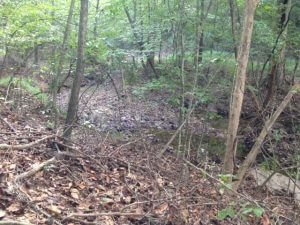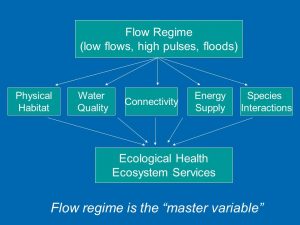Go with the Flow: Environmental Flows and Water Budget Learning Module Now Available

Tributary to Bolin Creek, NC Katherine Baer
The intermittent stream out past our backyard flows following a rain but sometimes it really rages for such a small creek – the result of parking lots, roads and rooftops that prevent rain from soaking into the ground and instead send it quickly to local streams. As a result, my creek like other urban waterways has a “flashy” hydrograph, meaning it spikes super-high following a rain compared to what a more natural condition would look like.
But have you ever wondered – what would a more natural streamflow look like – and how would you figure that out – a first step before figuring out what you can do to better protect or restore your local streams and rivers?
If so – you’re in luck! River Network has recently released our Science Module on Environmental Flows and Water Security a self-guided learning series that will introduce you to the concepts of water budgets and environmental flows and provide instruction on using tools that are now available online. Brian Richter, TNC Chief Scientist for Water and a River Network Board member provides two clear recordings on water budgets and environmental flows, covering topics like – what are environmental flows, why they matter and how they’re applied (video 2) as well as the value of and how to put together water budgets for a watershed or river basin (video 4). Both of these scientific concepts are key to creating and managing for water security and sustainability in our rivers – ensuring that we have enough water for people and nature into the future.
Next, Dave Blodgett from the U.S. Geological Survey steps through how to use and apply data available for investigating environmental flows in your watershed, available through the USGS Water Census Data Resources Portal. Using this tool provides access to real-time and

Environmental Flows Science Module Courtesy of Brian Richter, TNC
historic flow data so you can start applying flow information to your river and understanding the change in flows over time (video 3). Dave also explains how to use this information to create a water budget for your area (video 5).
You can watch these individually, but they’re really good in sequence as they build upon each other (start the popcorn!). And if you have any questions or are interested in learning more about how you might apply these tools in your watershed, please feel free to contact our Science Manager, Adam Griggs who can help you out further.
Also – see how some states are working to put these concepts into practice through their policies for water budgets and protecting and restoring flows in our report Protecting and Restoring Flows in Our Southeastern Rivers – A Synthesis of State Policies for Water Security and Sustainability.
Flow is often referred to as the “master variable” affecting a river’s ecological health – and these new resources are aimed at better understanding and managing for healthy flows.





[…] Rivers: A Synthesis of State Policies for Water Security and Sustainability”. They also discussed opportunities to work more in the future with Waterkeepers on these […]